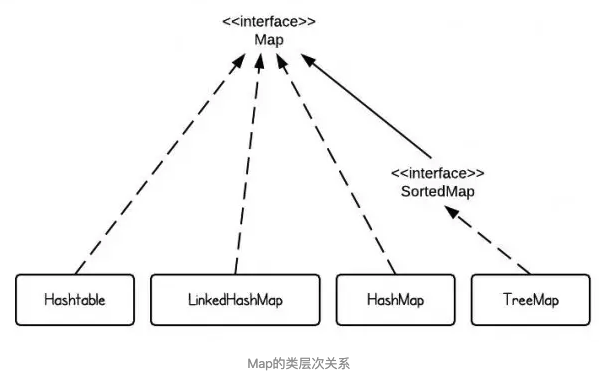Java-基础篇-Lambda操作Map
1. Java8新加入的lambda方法
| 接口类型 | 新加入的方法 |
|---|---|
| Map | forEach()、replaceAll()、merge()、compute()、computeIfAbsent()、computeIfPresent() |

由于继承关系,他们相应的子类也都会继承这些新方法。
2. forEach()
该方法签名为void forEach(BiConsumer<? super K,? super V> action),作用是对Map中的每个映射执行action指定的操作,其中BiConsumer是一个函数接口,里面有一个待实现方法void accept(T t, U u)。BinConsumer接口名字和accept()方法名字都不重要。
2.1 示例:遍历输出Map
需求:假设有一个成绩单Map,遍历输出Map中的所有映射关系.
2.2 Java8以前的代码
HashMap<String,Integer> map = new HashMap<>();
map.put("张三", 62);
map.put("李四", 66);
map.put("王麻子", 89);
for(Map.Entry<String,Integer> entry : map.entrySet()){
System.out.println(entry.getKey() + " => " + entry.getValue());
}
/**
输出:
李四 => 66
张三 => 62
王麻子 => 89
*/
2.3 匿名内部类代码
HashMap<String,Integer> map = new HashMap<>();
map.put("张三", 62);
map.put("李四", 66);
map.put("王麻子", 89);
map.forEach(new BiConsumer<String, Integer>() {
@Override
public void accept(String s, Integer integer) {
System.out.println(s + " => " + integer);
}
});
/**
输出:
李四 => 66
张三 => 62
王麻子 => 89
*/
2.4 使用lambda
HashMap<String,Integer> map = new HashMap<>();
map.put("张三", 62);
map.put("李四", 66);
map.put("王麻子", 89);
map.forEach((k,v)-> {
System.out.println(k + " => " + v);
});
/**
输出:
李四 => 66
张三 => 62
王麻子 => 89
*/
3.replaceAll()
该方法签名为replaceAll(BiFunction<? super K,? super V,? extends V> function),作用是对Map中的每个映射执行function指定的操作,并用function的执行结果替换原来的value,其中BiFunction是一个函数接口,里面有一个待实现方法R apply(T t, U u)
3.1 示例:将单词都转换成大写
需求:有一个数字到对应英文单词的Map,将单词都转换成大写.
3.2 Java8以前的代码
HashMap<Integer,String> map = new HashMap<>();
map.put(1, "c");
map.put(2, "go");
map.put(3, "java");
map.put(4, "php");
for (Map.Entry<Integer,String> entry : map.entrySet()){
entry.setValue(entry.getValue().toUpperCase());
}
System.out.println(map);
//输出:{1=C, 2=GO, 3=JAVA, 4=PHP}
3.3 匿名内部类代码
HashMap<Integer,String> map = new HashMap<>();
map.put(1, "c");
map.put(2, "go");
map.put(3, "java");
map.put(4, "php");
map.replaceAll(new BiFunction<Integer, String, String>() {
@Override
public String apply(Integer integer, String s) {
return s.toUpperCase();
}
});
System.out.println(map);
// 输出:{1=C, 2=GO, 3=JAVA, 4=PHP}
3.4 使用lambda
HashMap<Integer,String> map = new HashMap<>();
map.put(1, "c");
map.put(2, "go");
map.put(3, "java");
map.put(4, "php");
map.replaceAll((k,v)->v.toUpperCase());
System.out.println(map);
// 输出:{1=C, 2=GO, 3=JAVA, 4=PHP}
4. merge()
该方法签名为merge(K key, V value, BiFunction<? super V,? super V,? extends V> remappingFunction)。作用是:它将新的值赋值到 key (如果不存在)或更新给定的key 值对应的 value。即key存在则更新,不存在则赋值。
4.1 错误信息拼接
一个比较常见的场景是将新的错误信息拼接到原来的信息上,比如:
HashMap<String, String> stringStringHashMap = new HashMap<>(1);
stringStringHashMap.put("error", "执行错误,");
System.out.println(stringStringHashMap); // {error=执行错误}
// 使用merge
stringStringHashMap.merge("error", "其他错误信息.....", (v1, v2) -> v1 + v2);
System.out.println(stringStringHashMap); // {error=执行错误,其他错误信息.....}
4.2 其他示例
5.compute()
该方法签名为compute(K key, BiFunction<? super K,? super V,? extends V> remappingFunction),作用是把remappingFunction的计算结果关联到key上,如果计算结果为null,则在Map中删除key的映射.
5.1 统计一个List 中每个元素出现的次数
List<String> list = Arrays.asList("a", "b", "b", "c", "c", "c", "d", "d", "d", "f", "f", "g");
System.out.println("使用 compute 计算元素出现的次数:");
Map<String, Integer> countsMap = new HashMap<>(6);
// 此时:新值 = 旧值 + 1
list.forEach(str -> countsMap.compute(str, (k, v) -> v == null ? 1 : v + 1));
System.out.println(countsMap);
/**
使用 compute 计算元素出现的次数:
{a=1, b=2, c=3, d=3, f=2, g=1}
*/
6.computeIfAbsent()
该方法签名为V computeIfAbsent(K key, Function<? super K,? extends V> mappingFunction),
作用:只有在当前Map中不存在key值的映射或映射值为null时,才调用mappingFunction,并在mappingFunction执行结果非null时,将结果跟key关联.6.1 示例:条件判断和添加操作合二为一
computeIfAbsent()常用来对Map的某个key值建立初始化映射.比如我们要实现一个多值映射,Map的定义可能是Map<K,Set
6.2 Java8以前的代码
Map<Integer, Set<String>> map = new HashMap<>();
if(map.containsKey(1)){
map.get(1).add("PHP");
}else{
Set<String> valueSet = new HashSet<String>();
valueSet.add("PHP");
map.put(1, valueSet);
}
6.3 使用lambda
Map<Integer, Set<String>> map = new HashMap<>();
map.computeIfAbsent(1, v -> new HashSet<String>()).add("Java");
7.computeIfPresent()
该方法签名为V computeIfPresent(K key, BiFunction<? super K,? super V,? extends V> remappingFunction),作用跟computeIfAbsent()相反,即,只有在当前Map中存在key值的映射且非null时,才调用remappingFunction,如果remappingFunction执行结果为null,则删除key的映射,否则使用该结果替换key原来的映射.
7.1 使用示例
HashMap<String, Integer> map = new HashMap<>();
map.put("1", 1);
map.put("2", 2);
map.put("3", 3);
map.put("4", 3);
//只对map中存在的key对应的value进行操作
Integer integer = map.computeIfPresent("3", (k, v) -> v + 1);
System.out.printf("修改key=3得值为: %d\n", integer);
System.out.printf("修改后的map为: %s\n", map.toString());
// 触发remappingFunction,并返回执行结果为null,从而删除key=4
map.computeIfPresent("4", (k, v) -> {
System.out.println("调用remappingFunction = [k=" + k + "; v=" + v + "]");
return null;
});
System.out.printf("触发remappingFunction后的,map为: %s\n", map.toString());
/**
输出:
修改key=3得值为: 4
修改后的map为: {1=1, 2=2, 3=4, 4=3}
调用remappingFunction = [k=4; v=3]
触发remappingFunction后的,map为: {1=1, 2=2, 3=4}
*/
转载请注明来源,欢迎指出任何有错误或不够清晰的表达。
文章标题:Java-基础篇-Lambda操作Map
文章字数:1.6k
本文作者:猿码记
发布时间:2019-12-14 20:27
原始链接:liuqh.icu/2019/12/14/java-14-Lambda操作Map/版权声明: 转载请保留原文链接及作者。

